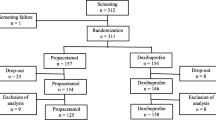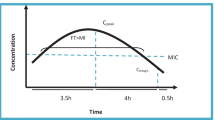Abstract
Although the serum sickness-like reaction (SSLR) in children after the administration of cefaclor has long been recognized, the exact mechanism of cefaclor-associated SSLR remains unclear. This study aims to investigate the association between intestinal mucosal permeability and cefaclor-associated SSLR in children. A total of 82 pediatric patients with upper respiratory tract infection following the cefaclor therapy was divided into cefaclor-associated SSLR positive group and negative group based on the presence or absence of SSLR after taking cefaclor, and 30 healthy volunteers served as control group. Urinary lactulose/mannitol (L/M) ratios and serum diamine oxidase (DAO) levels were determined in all cases on days 7, 9, 11, 13, and 15 after oral administration of cefaclor. The children in the control group were given the same measurements after enrollment in this study. From days 7 to 13, the urinary L/M ratio of children with cefaclor SSLR gradually increased and reached to the highest level of 0.38 ± 0.14 on day 13. Compared with the cefaclor-associated SSLR negative group and control group, urinary L/M ratios increased significantly in the cefaclor SSLR positive group on days 7, 9, 11, 13, and 15 after taking cefaclor, and serum levels of DAO following the treatment of cefaclor increased significantly in children with cefaclor SSLR on days 9, 11, 13, and 15. No significant difference in urinary L/M ratios and serum levels of DAO between SSLR negative group and control group through the entire experiment was observed. In conclusion, administration of cefaclor may induce SSLR in children by increasing the intestinal mucosal permeability and/or affecting the integrity of the intestinal mucosa. Determinations of urinary L/M ratios and serum DAO levels may be helpful for observing or predicting the occurrence of SSLR after administration of cefaclor, which will encourage physicians to proceed with extreme caution when prescribing cefaclor for pediatric patients.



Similar content being viewed by others
References
ADRAC (2009) Australian adverse drug reactions bulletin. Aust Adv Drug React Bull 28:5–8
Ammori BJ, Leeder PC, King RF, Barclay GR, Martin IG, Larvin M, McMahon MJ (1999) Early increase in intestinal permeability in patients with severe acute pancreatitis: correlation with endotoxemia, organ failure, and mortality. J Gastrointest Surg 3:252–262
Antunez C, Blanca-Lopez N, Torres MJ, Mayorga C, Perez-Inestrosa E, Montañez MI (2006) Immediate allergic reactions to cephalosporins: evaluation of cross-reactivity with a panel of penicillins and cephalosporins. J Allergy Clin Immunol 117:404–410
Behrens RH, Lunn PG, Northrop CA, Hanlon PW, Neale G (1987) Factors affecting the integrity of the intestinal mucosa of Gambian children. Am J Clin Nutr 45:1433–1441
Benjamin J, Makharia G, Ahuja V, Rajan KD, Kalaivani M, Gupta DS, Joshi YK (2012) Glutamine and whey protein improve intestinal permeability and morphology in patients with Crohn’s disease: a randomized controlled trial. Dig Dis Sci 57:1000–1012
Chávez-Servín JL, Castellote AI, López-Sabater MC (2004) Analysis of mono- and disaccharides in milk-based formulae by high-performance liquid chromatography with refractive index detection. J Chromatogr A 1043:211–215
Cox MA, Lewis KO, Cooper BT (1999) Measurement of small intestinal permeability markers, lactulose, and mannitol in serum: results in coeliac disease. Dig Dis Sci 2:402–406
D’Agostino L, Ciacci C, Daniele B (1984) Plasma diamine oxidase (DAO) and heparin. Dig Dis Sci 29:1070–1071
Daniele B, Secondulfo M, De Vivo R, Pignata S, De Magistris L, Delrio P, Palaia R, Barletta E, Tambaro R, Carratu R (2001) Effect of chemotherapy with 5-fluorouracil on intestinal permeability and absorption in patients with advanced colorectal cancer. J Clin Gastroenterol 3:228–230
Eccles MP, Grimshaw JM, Johnston M, Steen N, Pitts NB, Thomas R, Glidewell E, Maclennan G, Bonetti D, Walker A (2007) Applying psychological theories to evidence-based clinical practice: identifying factors predictive of managing URTI without antibiotics. Implement Sci 2:26
Elia M, Behrens R, Northrop C, Wraight P, Neale G (1987) Evaluation of mannitol, lactulose and 51Cr-labelled ethylene-diamine tetra-acetate as markers of intestinal permeability in man. Clin Sci 73:197–204
Feld JJ, Meddings J, Heathcote EJ (2006) Abnormal intestinal permeability in primary biliary cirrhosis. Dig Dis Sci 9:1607–1613
Fleming SC, Kapembwa MS, Laker MF, Levin GE, Griffin GE (1990) Rapid and simultaneous determination of lactulose and mannitol in urine, by HPLC with pulsed amperometric detection, for use in studies of intestinal permeability. Clin Chem 36:797–799
Galpin L, Manary MJ, Fleming K, Ou CN, Ashorn P, Shulman RJ (2005) Effect of Lactobacillus GG on intestinal integrity in Malawian children at risk of tropical enteropathy. Am J Clin Nutr 82:1040–1045
García-Martín E, Ayuso P, Martínez C, Agúndez J (2007) Improved analytical sensitivity reveals the occurrence of gender-related variability in diamine oxidase enzyme activity in healthy individuals. Clin Bio 40:1339–1341
Grouhi M, Hummel D, Roifman CM (1999) Anaphylactic reaction to oral cefaclor in a child. Pediatrics 103:e50
Hebert AA, Sigman ES, Levy ML (1991) Serum sickness-like reactions from cefaclor in children. J Am Acad Dermatol 25:805–808
Hossain MI, Nahar B, Hamadani JD, Ahmed T, Roy AK, Brown KH (2010) Intestinal mucosal permeability of severely underweight and non-malnourished Bangladeshi children and effects of nutritional rehabilitation. J Pediatr Gastroenterol Nutr 51:638–644
Jackson PG, Lessof MH, Baker RW, Ferrett J, MacDonald DM (1981) Intestinal permeability in patients with eczema and food allergy. Lancet 1:1285–1291
Jayalakshmi K, Ghoshal UC, Kumar S, Misra A, Roy R, Khetrapal CL (2009) Assessment of small intestinal permeability using 1H NMR spectroscopy. J Gastrointestin Liver Dis 18:27–32
Kalach N, Rocchiccioli F, Boissieu D, Benhamou PH, Dupont C (2001) Intestinal permeability in children: variation with age and reliability in the diagnosis of cow’s milk allergy. Acta Paediatrica 90:499–505
Kamei H, Hachisuka T, Nakao M, Takaqi K (2005) Quick recovery of serum diamine oxidase activity in patients undergoing total gastrectomy by oral enteral nutrition. Am J Surg 189:38–43
Kearns GL, Wheeler JG, Childress SH, Letzig LG (1994) Serum sickness-like reactions to cefaclor: role of hepatic metabolism and individual sensitivity. J Pediatr 125:805–811
Kim SH, Choi JH, Park HS (2004) Recognition of allergenic determinants to cefaclor in patients with cefaclor-induced anaphylaxis. J Allergy andClin Immunol 113:s73
King BA, Geelhoed GG (2003) Adverse skin and joint reactions associated with oral antibiotics in children: the role of cefaclor in serum sickness-like reactions. J Paediatr Child Health 39:677–681
Knowles S, Shaprio L, Shear NH (1997) Serious dermatologic reactions in children. Curr Opin Pediatr 9:388–395
Laker MF, Menzies IS (1977) Increase in human intestinal permeability following ingestion of hypertonic solutions. J Physiol 265:881–894
Lanas Á, Scarpignato C (2006) Microbial flora in NSAID-induced intestinal damage: a role for antibiotics? Digestion 73:136–150
Linskens RK, Huijsdens XW, Savelkoul PH, Vandenbroucke Grauls CM, Meuwissen SG (2001) The bacterial flora in inflammatory bowel disease: current insights in pathogenesis and the influence of antibiotics and probiotics. Scand J Gastroenterol Suppl 234:29–40
Luk GD, Bayless TM, Baylin SB (1980) Diamine oxidase. A circulating marker for rat intestinal mucosal maturation and integrity. J Clin Invest 66:66–70
Menzies IS, Laker MF, Pounder R (1979) Abnormal permeability to sugars in villous atrophy. Lancet 8152:1107–1109
Murray DL, Singer DA, Singer AB, Veldman JP (1980) Cefaclor—a cluster of adverse reactions. N Engl J Med 17:1003
NICE Short Clinical Guidelines Technical Team (2008) Respiratory tract infections—antibiotic prescribing. Prescribing of antibiotics for self-limiting respiratory tract infections in adults and children in primary care. National Institute for Health and Clinical Excellence, London, pp 1–121
Parshuram CS, Phillips RJ (1998) Retrospective review of antibiotic-associated serum sickness in children presenting to a paediatric emergency department [letter]. Med J Aust 169:116
Penalva JC, Martínez A, Esteban A (2002) Intestinal permeability alteration in acute pancreatitis. Pancreatology 2:167–187
Prussick R, Knowles S, Shear N (1994) Cutaneous drug reactions. Curr Probl Dermatol 6:81–124
Reyes H, Zapata R, Hernández I, Gotteland M, Sandoval L, Jirón MI, Palma J, Almuna R, Silva JJ (2006) Is a leaky gut involved in the pathogenesis of intrahepatic cholestasis of pregnancy? Hepatology 43:715–722
Romano A, Gaeta F, Valluzzi RL, Alonzi C, Viola M, Bousquet JP (2008) Diagnosing hypersensitivity reactions to cephalosporins in children. Pediatrics 122:521–527
Rooyakkers DR, van Eijk HM, Deutz NE (1996) Simple and sensitive multi-sugar-probe gut permeability test by high-performance liquid chromatography with fluorescence labeling. J Chromatogr A 730:99–105
Ruan P, Gong ZJ, Zhang QR (2004) Changes of plasma D(−)-lactate, diamine oxidase and endotoxin in patients with liver cirrhosis. Hepatobiliary Pancreat Dis Int 3:58–61
Soderholm JD, Olaison G, Lindberg E (1999) Different intestinal permeability patterns in relatives and spouses of patients with Crohn’s disease: an inherited defect in mucosal defence? Gut 44:96–100
Soensen SH, Proud FJ, Adam A, Rutgers HC, Batt RM (1993) A novel HPLC method for the simultaneous quantification of monosaccharides and disaccharides used in tests of intestinal function and permeability. Clin Chim Acta 221:115–125
Song WB, Lv YH, Zhang ZS, Li YN, Xiao LP, Yu XP, Wang YY, Ji HL, Ma L (2009) Soluble intercellular adhesion molecule-1, D-lactate and diamine oxidase in patients with inflammatory bowel disease. World J Gastroenterol 15:3916–3919
Spitz J, Hecht G, Taveras M, Aoys E, Alverdy J (1994) The effect of dexamethasone administration on rat intestinal permeability: the role of bacterial adherence. Gastroenterology 106:35–41
Stricker BH, Tijssen JG (1992) Serum sickness-like reactions to cefaclor. J Clin Epidemiol 45:1177–1184
Takagi K, Nakao M, Ogura Y, Nabeshima T, Kunii A (1994) Sensitive colorimetric assay of serum diamine oxidase. Clin Chim Acta 226:67–75
Ukabam SO, Homeida MMA, Cooper BT (1986) Small intestinal permeability in normal Sudanese subjects: evidence of tropical enteropathy. Trans R Soc Trop Med Hyg 80:204–207
Welcker K, Martin A, Kolle P, Siebeck M, Gross M (2004) Increased intestinal permeability in patients with inflammatory bowel disease. Eur J Res 9:456–460
Willumsen JF, Darling JC, Kitundu JA, Kingamkono RR, Msenqi AE, Mduma B, Sullivan KR, Tomkins AM (1997) Dietary management of acute diarrhoea in children: effect of fermented and amylase-digested weaning foods on intestinal permeability. J Pediatr Gastroenterol Nutr 24:235–241
Wong DM, Blumberg DA, Lowe LG (2006) Guidelines for the use of antibiotics in acute upper respiratory tract infections. Am Fam Physician 74:956–966
Acknowledgments
The authors are grateful to the children and parents who took part in the study. We also thank Dr. Shanshan Li (Iowa State University, USA) for helping in the modification of the manuscript and providing some useful suggestions in this study. Many thanks to Shenzhen Bureau of Science Technology and Information (grant: JC200903180532A to ZY), RFDP (20090002120055 to ZY), and Nanshan district Bureau of Science Technology for the funding of this study.
Conflict of interest
No competing financial interests exist.
Author information
Authors and Affiliations
Corresponding authors
Additional information
Zhen Zhang and Yun Xiang contributed equally to this work.
Rights and permissions
About this article
Cite this article
Zhang, Z., Xiang, Y., Wang, B. et al. Intestinal mucosal permeability of children with cefaclor-associated serum sickness-like reactions. Eur J Pediatr 172, 537–543 (2013). https://doi.org/10.1007/s00431-012-1926-y
Received:
Revised:
Accepted:
Published:
Issue Date:
DOI: https://doi.org/10.1007/s00431-012-1926-y




